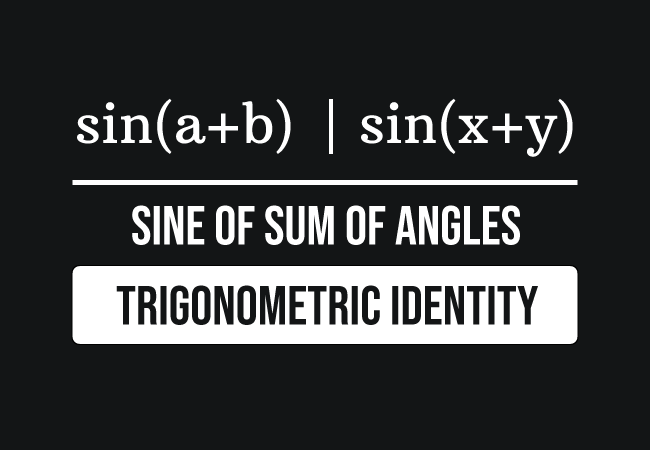$(1).\,\,$ $\sin{(a+b)}$ $\,=\,$ $\sin{a}\cos{b}$ $+$ $\cos{a}\sin{b}$
$(2).\,\,$ $\sin{(x+y)}$ $\,=\,$ $\sin{x}\cos{y}$ $+$ $\cos{x}\sin{y}$
Let’s assume that $a$ and $b$ are two variables, which represent two different angles. The sum of angles is written as $a+b$, which is a compound angle. The sine of a compound angle $a$ plus $b$ is written as $\sin(a+b)$ in mathematics.

The sine of sum of angles $a$ and $b$ is equal to the sum of the product of sine of angle $a$ and cosine of angle $b$, and the product of cosine of angle $a$ and sine of angle $b$.
$\sin{(a+b)}$ $\,=\,$ $\sin{a} \times \cos{b}$ $+$ $\cos{a} \times \sin{b}$
This mathematical equation is called the sine angle sum trigonometric identity in mathematics.
The sine angle sum trigonometric identity is used in two different cases in mathematics.
The sine of sum of two angles is expanded as the sum of products of sine and cosine of both angles.
$\implies$ $\sin{(a+b)}$ $\,=\,$ $\sin{(a)}\cos{(b)}$ $+$ $\cos{(a)}\sin{(b)}$
The sum of products of sine and cosine of both angles is simplified as the sine of sum of two angles.
$\implies$ $\sin{(a)}\cos{(b)}$ $+$ $\cos{(a)}\sin{(b)}$ $\,=\,$ $\sin{(a+b)}$
The angle sum trigonometric identity in sine function is written in several forms but it is popularly expressed in the following three forms.
$(1).\,\,$ $\sin{(A+B)}$ $\,=\,$ $\sin{A}\cos{B}$ $+$ $\cos{A}\sin{B}$
$(2).\,\,$ $\sin{(x+y)}$ $\,=\,$ $\sin{x}\cos{y}$ $+$ $\cos{x}\sin{y}$
$(3).\,\,$ $\sin{(\alpha+\beta)}$ $\,=\,$ $\sin{\alpha}\cos{\beta}$ $+$ $\cos{\alpha}\sin{\beta}$
Learn how to derive the sine of angle sum trigonometric identity by a geometric approach in trigonometry.
A free math education service for students to learn every math concept easily, for teachers to teach mathematics understandably and for mathematicians to share their maths researching projects.
Copyright © 2012 - 2025 Math Doubts, All Rights Reserved